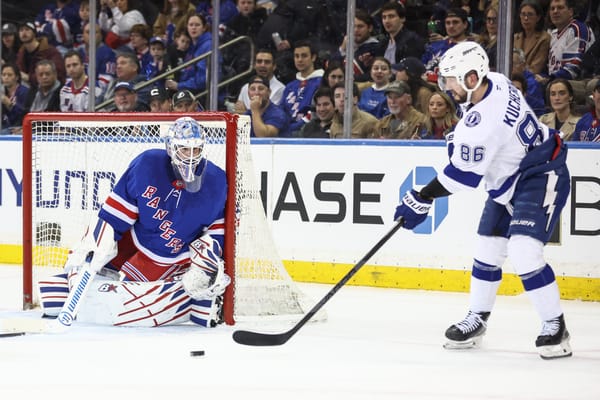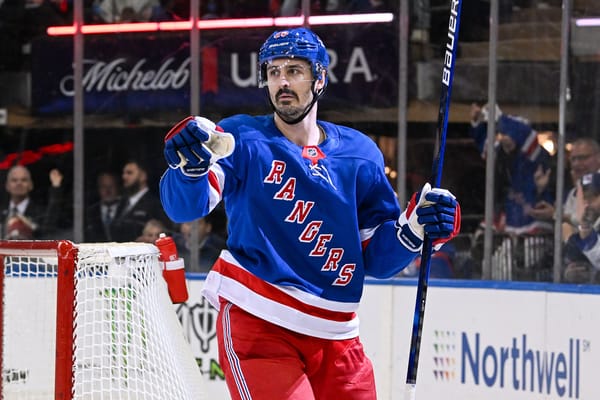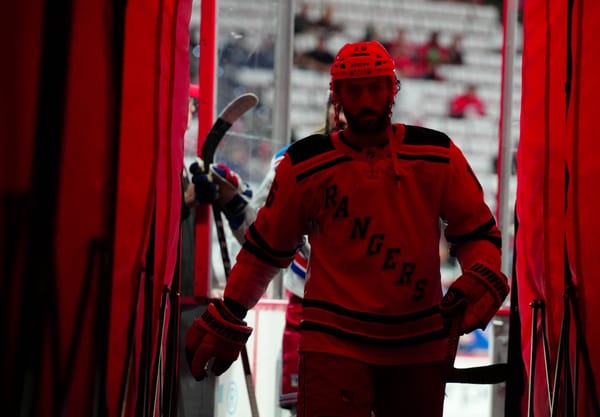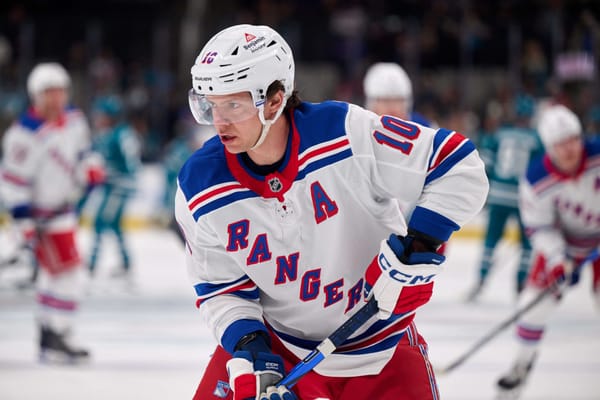Potential Cost-Effective Additions for Improving the Rangers’ Left Defense
The left side of the Rangers’ defense was arguably their biggest problem in 2019-2020. Likely to be limited by the salary cap, they’ll need to make improvements on the cheap.
On Monday we noted that, while we don’t have a crystal-clear picture of the Rangers’ offseason blueprint quite yet without knowing which players the team plans on keeping and moving as well as pandemic-induced salary cap fallout, it’s a general given that management will have little choice but to make cost-efficient improvements to the bottom-six.
The same is likely true for the left side of the defense. With the exception of Ryan Lindgren, the team’s options this season proved disastrous. Marc Staal and Libor Hajek tilted the ice heavily in the opposition’s favor, while Brendan Smith was an improvement but only in the way that a pulled muscle is an improvement on an ACL tear. There’s no sense in debating Brady Skjei because he’s now gone.
Granted, there is more room for a change in plans here. Depending on what the league makes the salary cap, whether the league gives teams amnesty buyouts, and/or if the Rangers move a potential big earner for next season such as Ryan Strome, Jacob Trouba, Tony DeAngelo, or Pavel Buchnevich, there may be wiggle room.
Even aside from the salary cap, there will be concerns about the Seattle Expansion Draft and keeping space open long-term for highly regarded prospects like K’Andre Miller and Zac Jones.
There may be a time and a place for discussing a more expensive splash on a defenseman like Minnesota’s Jonas Brodin ($4.17M cap hit) or free agents TJ Brodie or Brendan Dillon. Until the team that adding a more expensive addition on the left side clearly viable, the assumption should be that any additions will have to be financially sensitive. Here are a few potential candidates.
Andy Greene
Greene hasn’t had a flashy career, never flirting with an All-Star Game appearance or any major individual accolades. But he’s outlasted many who did. At 37 he may not be the player he once was, as his ability to drive offense has declined, but there haven’t been any questions about his ability to positively affect an NHL game. The skating and ability to drive offense have declined, but the hockey sense and situational defending ability are still present.
With Greene, there are the usual obstacles to sign a free agent. If he seeks $3 million or multiple years then it may be a non-starter. Even beyond that, though, it’s fair to wonder if Greene would have any interest in playing for the Rangers after practically his entire NHL career loyal to the Devils. That’s a personal question that only he can answer. The Rangers may have a compelling pitch, though. He’d be joining an exciting, competitive team on the rise and he wouldn’t have to move his family.
In theory, Greene looks like the most viable option for an immediate fix to the team’s defense without any salary cap hurt. In practice, he may or may not be the most unobtainable on the list.
Jon Merrill
Merrill has had an interesting career. Drafted 38th overall in 2010 out of the US National Team Development Program, Merrill was at one point the Devils’ top defense prospect. He made his debut in 2013 and spent four seasons in New Jersey where he struggled. Vegas picked him up as one of their more forgettable picks of the 2017 Expansion Draft but he’s actually found his game and turned into a dependable shutdown defenseman. Per Evolving Hockey, Merrill’s defensive contributions this season. have been worth 4.1 goals more than the average player, which ranks 20th among all NHL defensemen.
The biggest question mark with Merrill is what kind of contract he can get on the open market. Evolving Hockey’s projections don’t offer much clarity.
Again, between the moves the Rangers plan on making and the unknown salary cap for 2020-2021, it’s hard to pinpoint exactly what the Rangers can and can’t afford. Generally speaking, though, a long-term deal at $3-plus million would not only be an incredibly tough fit but probably inadvisable as a standalone deal for a player of Merrill’s caliber. If the Rangers could grab him on a one- or two-year deal in the range of $1.75M-$2.4M deal, then he could be a viable solution to improving the left side of the defense.
Oscar Fantenberg
An undrafted defenseman out of Sweden, Fantenberg signed with the Los Angeles Kings in 2017 as a 25-year-old and has carved out a respectable career in North America, playing 124 games over the last three seasons for LA, Calgary, and Vancouver.
Not that this list is in any thought out order, but we’re starting to trend away from difference makers. Ideally the Rangers will be able to add a needle-mover, but cap constraints and a limited selection may mean they may need to settle for damage control. Fantenberg is not a diversely skilled player, but he is fairly good at defending the rush and generally suppresses shots. Put him on a pairing with a more complete puck-mover like Fox, DeAngelo, or (theoretically) Trouba and Fantenberg can do a job. The Rangers could do worse for a 6/7 defenseman.
Christian Djoos
Djoos started his NHL career with the Capitals, spending parts of two seasons in DC and even playing 22 games during their Cup run in 2018. He found himself the victim of a roster crunch this season and was demoted to the AHL. He was traded to Anaheim at the deadline for Daniel Sprong, a similarly in-limbo AHLer.
The Ducks need a hard reset and Djoos is an arbitration-eligible restricted free agent who turns 26 in August. Their plans to him could go either way. Maybe they see him as a player worth hanging on to, or maybe they don’t particularly rate him and would rather bank a fifth-round pick from the Rangers than give him the required $1.25 million qualifying offer.
What the Rangers really need right now is a defenseman who can hold down the fort and let a partner like Trouba or DeAngelo spread his offensive wings. Djoos is admittedly not that as he’s more someone who transitions the puck and creates shots. However, he’s not as leaky as Quinn’s current options within the organization and if the Rangers are going to bleed shots regardless then they might as well stack the deck offensively.
Sami Niku
A seventh-round pick by the Winnipeg Jets in 2015, Niku’s stock climbed with solid play in the Finnish Liiga and then dominance in the AHL. He won the AHL’s equivalent to the Norris Trophy as a 20-year-old rookie, posting 16 goals and 38 assists in 76 games. He’s since bounced between Winnipeg and the AHL, playing 46 games over the last two seasons as he’s failed to establish himself games even despite Winnipeg’s defensive and injury struggles.
In fairness to Winnipeg, Niku has struggled in his NHL games, but he’s played incredibly well at lower levels and could thrive with a change of scenery in a different system. He’ll be 24 next October and if he doesn’t start the season in the NHL then he will require waivers.
Niku is risky compared to other options because there are no guarantees he will prove to be an NHL-caliber player. But he does have potential as a major difference-maker, and if he achieves it then he could be a piece of the puzzle for the long haul. A skilled player who may not be good enough is a better investment than the Rangers’ current crop of low-upside lefties who are definitely not good enough.
Sebastian Aho (NYI)
Not to be confused with Carolina Hurricanes’ star forward Sebastian Aho, this Sebastian Aho is a left-handed defenseman drafted by the Islanders in 2017. Aho played extremely well in the Swedish Hockey League for Skelleftea, highlighted by 30 points in 50 games as a 20-year-old in 2016-17. He’s performed similarly well for the Islanders’ AHL affiliate in Bridgeport and earned 22 NHL games in 2017-18, holding his own.
For whatever reasons, Aho hasn’t gotten a chance in the last two NHL seasons despite registering 76 points in 116 AHL games. Aho is now 24 years old and, like Niku, will want to be in the NHL one way or another next season. He too will require waivers next season, and the Islanders already have three lefties in Nick Leddy, Devon Toews, and Adam Pelech staunchly on the roster. Re-signing Andy Greene is maybe even a possibility as well.
So it seems that Aho could be on the outside looking in. Islanders’ General Manager Lou Lamoriello strongly abides by his principles and he has never made a trade with the Rangers in over three decades as an NHL GM, so acquiring Aho may be Mission Impossible even if the Islanders do put him on the market. Still, he’s a talented defenseman and the Islanders may have limited options, so the Rangers should at least do their due dilligence.
Jesper Sellgren
I’ve been enthusiastic about Sellgren as a darkhorse prospect for a while now, as he stood out to me at the 2017 World Junior Summer Showcase and I’ve seen him play many times in the SHL, particularly in the last two seasons as Nils Lundkvist’s teammate at Lulea. Sellgren went undrafted in 2017 but was scooped up in the sixth-round by the Carolina Hurricanes in 2018.
Sellgren has been a major driver of play at the junior and SHL levels. This past season, Lulea out-attempted the opposition 611-489 with Sellgren on the ice at five-on-five, and that 55.55 shot attempts percentage (Corsi) ranked fourth among all SHL defensemen who played at least 15 games.
That data is devoid of context such as teammates, opposition, and situational play, but the extreme ends of the spectrum are usually more reliable. Sellgren’s playing style is conducive to driving possession. He’s a good skater who will collect pucks and quickly transition play vertically with efficient outlets. He’s undersized but reads the ice well.
Eight goals and 21 assists in 47 games is a pretty good yield for the SHL, especially since he wasn’t seeing particularly opportunistic offensive minutes. As an NHL player Sellgren likely wouldn’t be a big offensive zone contributor but rather the guy who gets the puck into the offensive zone for others to build on.
Sellgren joined the Hurricanes’ AHL affiliate in 18-19 for their playoff run and contributed, but no obvious path to the NHL for 19-20 prompted his return to Lulea. The current Hurricanes’ depth chart is even less conducive to upward mobility going forward. Jacob Slavin, Jake Gardiner, and now Brady Skjei are all under contract in Carolina for at least the next three seasons while former first-round picks Jake Bean and Haydn Fleury are clearly superior prospects who have already seen NHL. Unless Carolina makes big moves or is willing to stack the roster with only left-handed defensemen, Sellgren is seemingly on the outside looking in. Maybe the Rangers could return to a familiar trade partner and acquire him for a late pick or forward prospect. Sellgren is not a guarantee to be ready for the NHL next season, or ever, really, but he’d give the Rangers another option.




